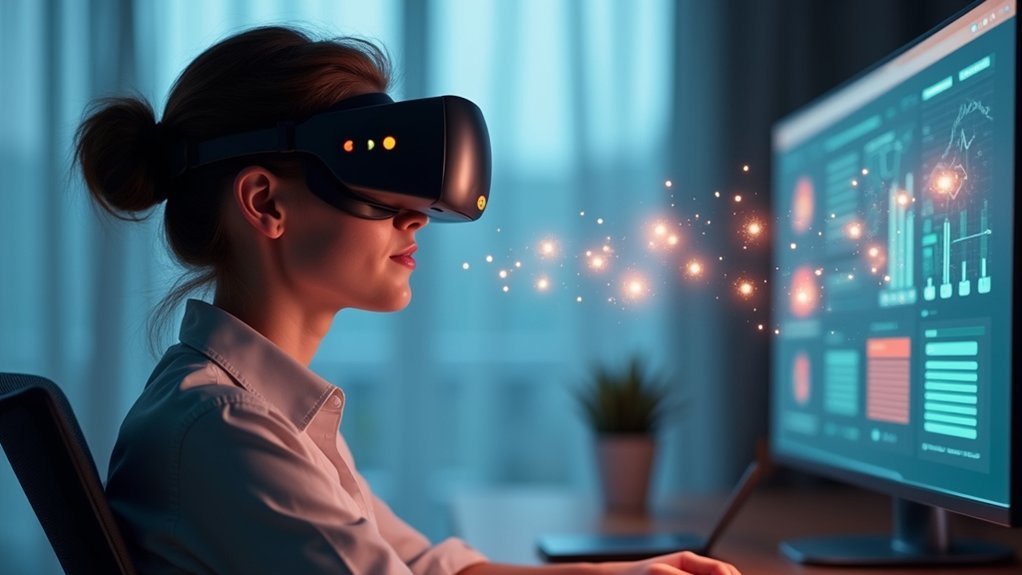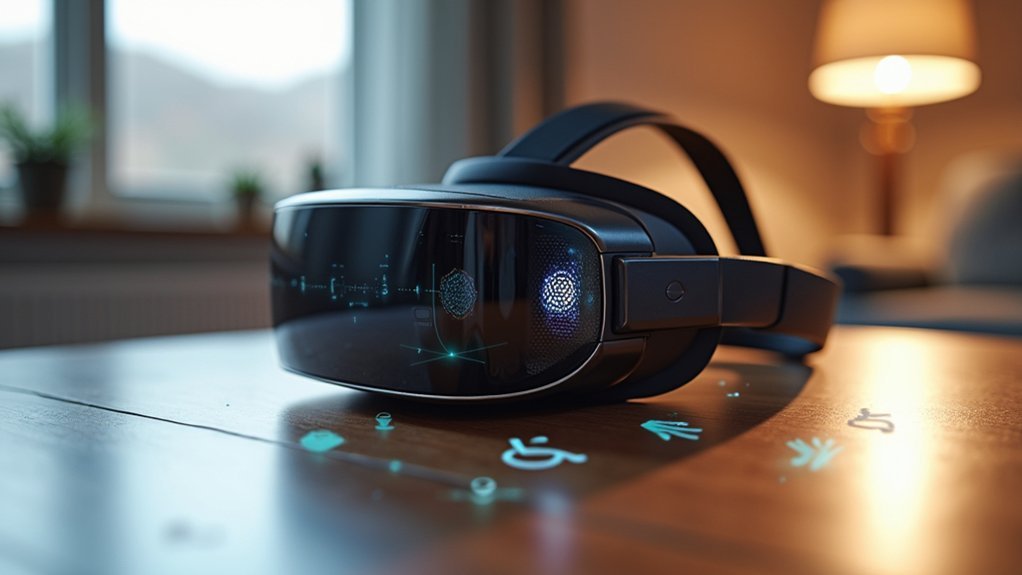You’ll find that modern headsets offer transformative eye tracking accessibility features like Dwell Control for hands-free navigation, adjustable pointer sensitivity for precise cursor movement, and gaze-based menu selection that responds to your natural eye movements. Advanced calibration systems adapt to your unique patterns using machine learning, while blink detection converts eye movements into commands. These features include saccadic movement recognition, eye strain reduction technology, and multi-user profiles that make headsets truly inclusive for users with mobility challenges—and there’s much more to explore.
Dwell Control for Hands-Free Navigation

When traditional touch or gesture controls aren’t accessible, Dwell Control transforms your eye movements into a powerful navigation tool for headset interfaces.
This hands-free navigation system lets you perform essential actions like tapping, scrolling, long pressing, and dragging simply by looking at screen elements. The accessibility feature proves especially valuable for users with limited mobility or dexterity challenges.
You can customize sensitivity and duration settings to create personalized interactions that match your specific needs.
The Apple Vision Pro utilizes sophisticated on-device machine learning to accurately track your gaze, ensuring reliable performance during navigation tasks.
This technology makes digital interfaces truly inclusive, eliminating barriers that might prevent you from fully experiencing immersive content and applications within your headset environment.
Pointer Control With Adjustable Sensitivity
You’ll find that pointer control’s adjustable sensitivity transforms how you navigate headset interfaces, giving you precise control over cursor movement through head, wrist, or finger gestures.
The sensitivity adjustment methods let you fine-tune responsiveness to match your specific motor abilities and comfort preferences.
These precision control settings guarantee you can interact with on-screen elements accurately, whether you need slower, more deliberate movements or faster navigation speeds.
Sensitivity Adjustment Methods
Because individuals have varying degrees of mobility and motor control, pointer control in headsets incorporates adjustable sensitivity settings that can be calibrated based on head, wrist, or index finger position.
This eye tracking accessibility feature provides a tailored experience by allowing you to fine-tune responsiveness according to your specific needs. You can select different sensitivity levels to accommodate mobility challenges, ensuring the interaction method remains comfortable and efficient.
For users with disabilities, these customizable settings enable precise navigation within the headset environment. You’ll find multiple adjustment options that help you achieve ideal interaction based on your physical capabilities.
This flexibility enhances usability while maintaining accuracy, making the technology more inclusive and accessible for diverse user requirements.
Precision Control Settings
Precision control settings transform pointer navigation into a highly customizable experience that adapts to your unique physical capabilities.
These advanced movement sensitivity settings let you fine-tune how your head, wrist, or finger movements translate into cursor actions across digital environments. You’ll find granular controls that adjust response thresholds, acceleration curves, and dwell times to match your mobility level perfectly.
When you have limited dexterity, adjustable sensitivity becomes essential for maintaining control without overcompensating for minor movements.
The Pointer Control system learns your interaction patterns, automatically calibrating to improve the accuracy of interactions over time. This adaptive technology guarantees you can precisely select small interface elements, scroll through content smoothly, and navigate complex menus with confidence, creating a truly personalized experience.
Gaze-Based Menu Selection

Gaze-based menu selection transforms how you interact with headset interfaces by letting you navigate and choose options through eye movements alone.
This accessibility feature uses advanced eye tracking technology to interpret where you’re looking, enabling activation of on-screen elements without physical interaction. It’s particularly valuable for individuals with mobility impairments who need alternative input methods.
Dwell Control integrates seamlessly with this system, requiring you to focus on items for preset durations to make selections.
This creates an intuitive hands-free experience that feels natural after brief practice. The system offers quick calibration for personalized setup, accommodating your specific needs and preferences.
Developers can easily implement gaze-based menu selection into existing user interfaces, making accessibility improvements straightforward across applications.
Eye Movement Calibration Systems
You’ll find that modern eye tracking headsets streamline the setup process through intuitive calibration routines that take just minutes to complete.
These systems leverage machine learning algorithms to analyze your unique eye movement patterns and continuously refine their accuracy based on your interactions.
The calibration adapts specifically to your visual behavior, ensuring the headset responds precisely to your gaze patterns and provides consistent performance across different applications.
Quick Setup Process
Within seconds, modern eye movement calibration systems get you up and running with minimal effort. These streamlined processes give you quick access to navigation features without complex setup procedures.
Your headset’s on-device machine learning adapts instantly to your unique eye movements, eliminating lengthy configuration times that traditional systems require.
The calibration process involves following simple visual prompts displayed on your device. You’ll look at specific points while the front-facing camera tracks your facial movements and eye positioning. This guarantees accurate tracking and responsive control for peak performance.
The entire eye movement calibration happens locally on your headset, protecting your privacy since no data leaves your device.
Once calibrated, you gain immediate access to hands-free navigation, making these systems particularly valuable for users with mobility impairments who need alternative input methods.
Machine Learning Accuracy
Although traditional eye tracking required extensive training periods, machine learning algorithms now achieve remarkable precision by continuously analyzing your unique eye patterns and movement characteristics.
Your device’s front-facing camera captures subtle eye movements while sophisticated calibration systems adapt to your individual traits over time.
The machine learning accuracy improvements deliver three key benefits:
- Personalized adaptation – Algorithms learn your specific eye behaviors, ensuring consistent eye tracking performance.
- Real-time optimization – Continuous refinement enhances accuracy without requiring manual recalibration.
- Privacy protection – All data remains securely stored on your device, never shared externally.
These advancements enable features like Dwell Control, where you can activate interface elements through natural eye movements.
This technology creates a seamless hands-free experience that responds precisely to your visual attention.
Personalized Calibration Methods
Building on these machine learning foundations, personalized calibration methods transform how your headset adapts to your specific visual patterns. Your system creates individual user profiles through a brief setup process where you’ll look at designated screen points, enabling accurate tracking of your unique eye movement patterns.
These machine learning algorithms continuously learn from your interactions, improving responsiveness over time for enhanced usability and comfort.
The calibration process accommodates users with visual impairment or mobility challenges, ensuring everyone receives a tailored experience. Your headset’s front-facing camera works with sophisticated software to understand how your eyes naturally move and respond.
This personalized calibration eliminates guesswork, delivering precise navigation and seamless interaction with digital interfaces that truly understand your individual needs and preferences.
Blink Detection for Command Activation
Since traditional input methods can pose significant barriers for users with motor impairments, blink detection transforms how you’ll interact with your headset by turning simple eye blinks into powerful commands.
This hands-free method leverages advanced eye tracking technology to distinguish between intentional blinks and natural eye movements, ensuring accurate command activation.
You’ll benefit from three key advantages:
- Customizable sensitivity settings that adapt to your specific blinking patterns and preferences
- Enhanced independence for users with limited mobility or reduced motor skills
- Seamless user experience that minimizes physical interactions while maintaining full device control
The technology’s precision means you won’t accidentally trigger commands during normal blinking, while intentional blinks reliably execute your desired actions, creating an intuitive and accessible interface.
Pupil Tracking for Focus Enhancement
While blink detection handles command activation, pupil tracking takes your headset interaction to the next level by precisely detecting where you’re looking and how intensely you’re focusing on specific elements.
This focus enhancement technology provides real-time feedback that transforms how you navigate virtual environments, making them more responsive to your visual attention.
Through advanced machine learning algorithms, pupil tracking distinguishes between different concentration levels, creating more precise interactions.
You’ll find this particularly valuable if you have mobility impairments, as it enables you to control devices entirely through eye movements.
These accessibility features create truly inclusive environments where your gaze becomes a powerful navigation tool, allowing hands-free operation that adapts dynamically to your focus patterns and visual needs.
Saccadic Movement Recognition
Saccadic movements—those lightning-fast jumps your eyes make when shifting focus from one point to another—represent the backbone of natural vision that eye tracking technology must master for truly intuitive interaction.
Advanced saccadic movement recognition transforms how you’ll navigate digital interfaces through gaze alone, eliminating physical input requirements.
Machine learning algorithms continuously adapt to your unique eye movement patterns, improving accuracy over time. This technology particularly benefits users with mobility impairments by enabling independent device control.
Key advantages include:
- Dwell Control activation – Simply look at interface elements to trigger actions
- Seamless navigation – Natural eye movements replace traditional input methods
- Enhanced accessibility – Provides critical independence for users with physical limitations
This sophisticated recognition system fundamentally improves user experience by making technology respond naturally to your vision patterns.
Eye Strain Reduction Technology
As headset usage extends into hours-long sessions, eye strain reduction technology becomes essential for maintaining visual comfort and preventing fatigue.
You’ll benefit from adjustable refresh rates that eliminate flicker and adaptive brightness settings that automatically respond to lighting conditions. Blue light filtering integrated into headset lenses reduces harmful wavelengths that contribute to eye fatigue.
Modern eye-tracking features monitor your gaze patterns and dynamically adjust display settings to optimize focus areas while reducing unnecessary visual stimuli.
Eye-tracking technology intelligently adapts your display in real-time, focusing visual resources where you’re actually looking while minimizing distracting elements.
Ergonomic design elements like proper weight distribution and adjustable fit minimize physical strain on your eyes and neck.
Regular software updates continuously improve eye strain reduction algorithms, ensuring you receive the latest advancements in visual comfort technology for extended headset sessions.
Multi-User Calibration Profiles
You’ll find that setting up your individual calibration profile requires just a few minutes of following simple on-screen prompts that map your unique eye movements and characteristics.
Once you’ve completed the initial setup, the system stores your personalized settings alongside other users’ profiles for future use.
You can then switch between different user profiles in seconds, making it easy to share headsets in family or classroom environments without sacrificing tracking accuracy.
Individual Setup Process
When multiple people share the same headset, individual calibration profiles become essential for accurate eye tracking performance.
You’ll benefit from personalized eye tracking settings that recognize your unique eye movements and optimize the accessibility experience specifically for you.
The calibration process utilizes on-device machine learning to quickly learn your eye movement patterns:
- Position the headset correctly and follow the on-screen prompts that guide you through eye movement exercises.
- Complete calibration in seconds thanks to advanced machine learning algorithms that rapidly process your data.
- Save calibration profiles for future use, enabling a seamless shift between different users without repeated setup.
You can adjust profiles over time to accommodate vision changes or personal preferences, ensuring your eye tracking remains accurate and responsive.
Profile Switching Speed
Once you’ve created your individual calibration profile, shifting between different users becomes remarkably fast and efficient.
Profile switching speed in modern eye tracking systems allows you to make rapid calibration adjustments within seconds, dramatically improving accessibility for multiple users in shared environments. You’ll find this feature invaluable in educational and collaborative settings where headsets change hands frequently.
Machine learning algorithms recognize your previous interactions and automatically apply appropriate calibration settings, eliminating extensive setup time.
This streamlined process enhances your user experience by minimizing downtime and enabling seamless shifts between users. Whether you’re in a classroom or workplace, quick profile switching guarantees each person’s eye movements are accurately tracked without compromising real-time application performance.
Real-Time Gaze Analytics
As your eyes dart across the screen, real-time gaze analytics capture every micro-movement, transforming your natural looking patterns into actionable data that headset applications use to enhance your experience instantly.
This eye tracking technology revolutionizes how you interact with digital environments, especially if you have mobility impairments.
Here’s how real-time gaze analytics enhance your accessibility:
Real-time gaze analytics transform natural eye movements into powerful accessibility tools, enabling hands-free digital interaction for users with mobility impairments.
- Dwell Control activation – You’ll select interface elements simply by maintaining your gaze for predetermined durations, enabling complete hands-free interaction.
- Dynamic content adjustment – Applications automatically adapt based on where you’re looking, optimizing user engagement through personalized experiences.
- Attention pattern analysis – Developers gain insights into your focus areas, allowing them to refine accessibility features and create more intuitive interfaces.
This technology transforms natural eye movements into powerful control mechanisms.
Frequently Asked Questions
Which Headset Has Eye Tracking?
You’ll find eye tracking in the Apple Vision Pro headset, which uses advanced technology and on-device machine learning to track your eye movements for seamless navigation and accessibility features.
Do VR Headsets Track Eye Movement?
Yes, many VR headsets track your eye movements using infrared cameras and sensors. You’ll find this technology in premium models like Apple Vision Pro, PICO 4 Enterprise, and Varjo headsets for enhanced interaction.
What Are the Two Types of Eye Tracking Devices?
You’ll encounter two main types of eye tracking devices: remote eye trackers that position away from you requiring calibration, and integrated eye trackers built directly into your headset for seamless tracking.
What Is the Difference Between Gaze Detection and Eye Tracking?
Gaze detection simply identifies where you’re looking, while eye tracking precisely measures your eye movements and positions. You’ll find gaze detection works for basic attention monitoring, but eye tracking enables detailed control.
In Summary
You’ve discovered powerful eye tracking features that’ll transform your headset experience. Whether you’re steering through dwell control, customizing pointer sensitivity, or reducing eye strain, these accessibility tools put you in complete control. You’ll find that blink detection and saccadic recognition respond naturally to your movements, while multi-user profiles guarantee everyone gets personalized access. With real-time analytics tracking your progress, you’re equipped with everything needed for seamless, hands-free interaction.





Leave a Reply